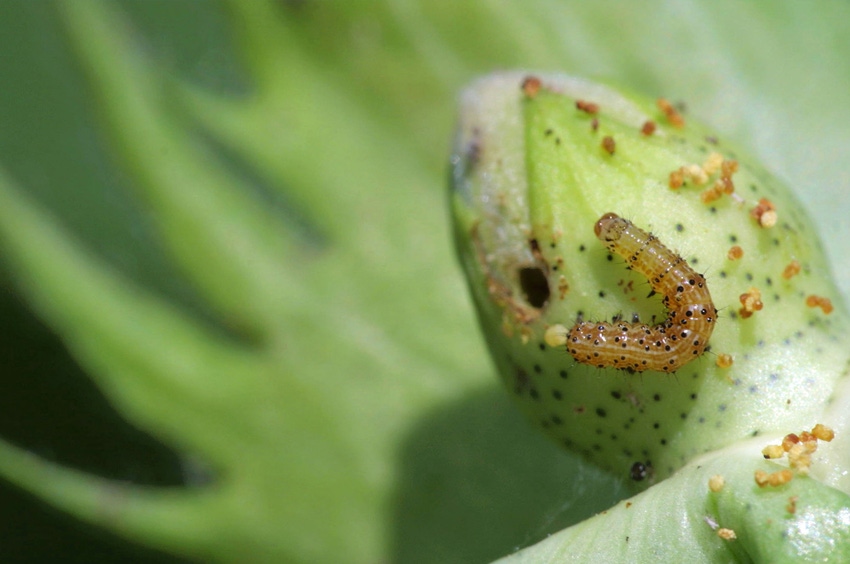
When it comes to bollworm resistance in Bt cotton, resistance isn’t the same as immunity, a state integrated pest management coordinator said at the Consultants' Conference at the 2019 Beltwide Cotton Conferences.
“It’s resistance, but it doesn’t mean you can’t still kill the worms with increased doses of insecticide,” says Dr. David Kerns, professor and IPM coordinator, Texas A&M University.
Kerns presented a state-by-state overview of trials testing bollworm resistance to the Bt genes Cry1Ac, Cry2Ab2, and Vip3a, the crystal (Cry) and vegetative proteins (Vip) that target specific caterpillar pests such as beet armyworm, cotton bollworm, and tobacco budworm.
Cry1Ac is the base toxin in Bollgard, Bollgard 1, Bollgard II and WideStrike technologies, while Cry2Ab2 is the primary toxin in Bollgard II, Bollgard 3, and TwinLink. Vip3a is the three-gene trait found in WideStike 3, Bollgard 3, or TwinLink Plus.

Dr. David Kerns, professor and IPM coordinator, Texas A&M University
BIOASSAYS
Over the last three years, Kerns says, a series of full-range bioassays have been run to measure bollworm resistance in Bt cotton in four labs located across the cotton belt: College Station, Texas; Stoneville, Miss.; Plymouth, N.C.; and west Georgia.
Assays, a procedure used for measurement, are conducted in little tray cups containing diet where a Bt toxin is placed on top of the diet and then infested with neonate larvae. The data collected are from dead larvae plus first instar. The field-collected strains are then compared to a laboratory strain that computes resistance ratios.
“We seem to have a more severe problem of resistance in the Mid-South and Texas,” says Kerns. “As we move further East, those percentages begin to drop.”
2018 statewide resistance monitoring results:
Texas
Cry1Ac: 92.9 percent of population tested resistant
Cry2Ab2: 70 percent of population tested resistant
Vip3a: no resistance detected
Louisiana (tested four populations)
Cry1Ac: three of the four populations tested resistant; one population, collected out of sweet cover in the early spring, came back as susceptible
Cry2Ab2: 75 percent of population tested resistant; some very high resistance. “We have one that’s over 100-fold,” says Kerns.
Vip3a: no resistance detected
Arkansas
Cry1Ac: 75 percent of population tested resistant; “all very high”
Cry2Ab2: 75 percent of population tested resistant
Vip3a: two evaluations, both tested susceptible
Mississippi
Cry1Ac: 100 percent of population tested resistant
Cry2Ab2: 90 percent of population tested resistant; one population, from a patche of crimson clover, tested susceptible
Vip3a: one population evaluated, tested susceptible
Tennessee (two populations)
Cry1Ac: both populations tested resistant
Cry2Ab2: one population tested resistant
Vip3a: both susceptible
Georgia
Cry1Ac: 37.5 percent of population tested resistant
Cry2Ab2: 50 percent of population tested resistant
Vip3a: no resistance detected
South Carolina
Cry1Ac: 33 percent of population tested resistant
Cry2Ab2: 50 percent of population tested resistant
Vip3a: no resistance detected
North Carolina (two populations)
Cry1Ac: one tested resistant, the other did not
Cry2Ab2: one tested resistant, the other did not
Vip3a: three populations, no resistance detected
Virginia
Cry2Ab2: no resistance detected
Vip3a: two populations, no resistance detected
“We definitely have resistance to Bt. I think from our assessments of Vip, it still looks good. But we still have concerns with resistance developing to the Vip technology — it's the only toxin that really seems to be holding its own consistently,” says Kerns.
With resistance, is there still value to the technology? Kerns says, “Yes.”
In trials conducted in the mid-South and Texas, when comparing the reduction in fruit damage in Bt cotton versus non-Bt, Kerns says with WideStike technology, they saw a 50 percent reduction in fruit damage and a 92 percent reduction with Vip, WideStrike 3. With TwinLink, fruit damage reduction ran a little more than 80 percent while TwinLink Plus was closer to 95 percent. With Bollgard II, the reduction was about 80 percent and closer to 95 percent in Bollgard 3, says Kerns.
“So, the technologies do bring something to the table, it's just how much they bring,” he says.
When it comes to management of Bt cotton, the next question often asked is do foliar sprays pay? Dr. Jeff Gore, Mississippi State University, told the crowd of consultants, “yes.”
Looking at the value of spraying Bt cotton from multiple tests conducted from 2017 and 2018 in the mid-South, Gore says whether it be two-gene or three-gene cotton, there is a yield benefit from applying Diamide sprays.
“On non-Bt cotton, obviously there was a big benefit for making foliar sprays. On the two gene cotton, it’s not quite as dramatic but still fairly consistent, averaging about 160 to 180 pounds of lint benefit from the two Prevathon sprays. And then with the three-gene cotton in 2017, this is from my trials at Stoneville, we had fairly high bollworm pressure that year, and in that situation, we even saw some benefit from spraying the cotton with the Vip technology.
“So, the main takeaway is there are times, though rare, when even the three-gene technologies are going to need to be sprayed,” says Gore.
About the Author(s)
You May Also Like






